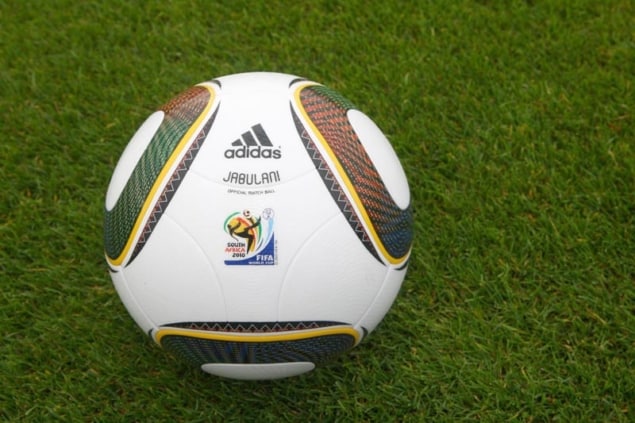
The engineer who led the testing of the ball for the FIFA World Cup – which gets under way this Friday – is defending the product despite a torrent of criticism from leading footballers. In the British press it is the goalkeepers who seem to be most unhappy, with the England number one, David James, describing the ball as “horrible” and “dreadful”, and his Italian counterpart, Gianluigi Buffon, fearing that its “unpredictability” could ruin the tournament.
The new ball, called the Jabulani, meaning “celebrate” in isiZulu, was unveiled by the sports manufacturing firm Adidas in December of last year. Loughborough University in the UK was the exclusive research partner, where a group of engineers spent four years testing and developing the aerodynamic features of the ball. This included a “kicking robot” positioned in a wind tunnel to see how the ball responded to aerodynamic instabilities. The final design introduces a new texture, trademarked as “Grip ‘n’ Groove”, and a new manufacturing process. When combined these features are supposed to make the ball more round and more predictable in flight.
The flight of a good quality match ball is noticeably faster and more reliable than that of a smooth plastic football that you might buy at a local grocery store. When a smooth ball moves through the atmosphere, the drag is large – being proportional to the surface area of the ball coming into contact with the air. And because the kinematic energy of the ball is converted into heat at such a high rate, the air flows cannot recombine behind the ball. This creates a zone of turbulent eddies in the wake of the ball, which can cause the ball’s motion to become unpredictable.
All-important seams
Higher quality balls are designed to reduce drag by having a surface made from several panels stitched together. These indentations trigger small instabilities at the boundary between the ball’s surface and the air. The result is twofold: the drag is reduced because the airflows no longer oppose the flight of the ball in such a uniform way; and the flight is more reliable because the mixing effects at the ball-air boundary enable airflows to recombine behind the ball, thus avoiding a wake of turbulent eddies.
Ball manufacturers for a World Cup are on a hiding to nothing. Whatever they do they’ll get hammered. Steve Haake, Sheffield Hallam University
The Jabulani ball is touted as offering both of these qualities, being both fast and reliable. It is moulded from panels of ethylene-vinyl acetate, a polymer used in shoes and other athletic materials to absorb physical shock, and thermoplastic polyurethanes, another group of highly elastic plastics. The panels are thermally bonded rather than being stitched together, which enabled the researchers to experiment with a larger range of groove shapes. The final design, according to the researchers, is a ball that travels 5% faster than previous balls while behaving in a smoother, more predictable way.
“The laws of physics mean that we cannot eliminate the possibility of unstable flight, but we can include features that reduce its likelihood and effect,” says Andy Harland, who led the team of engineers at Loughborough University. “We also investigated how groove width, depth and shape can affect aerodynamic side forces and have learned some features are highly sensitive,” he adds.
‘It moves all over’
But the ball has not been well received by several players, who are claiming that the Jabulani is in fact far less predictable than previous balls. Tim Howard, the US goalkeeper is reported in The Times as saying: “It moves all over. If you hit five balls with the same striking motion you wouldn’t get the same result.”
This sentiment is backed up Derek Leinweber, a physicist at the University of Adelaide, who has put the ball through his own series of aerodynamic tests, comparing the Jabulani’s performance with the ball from the previous World Cup, the Teamgeist. “The Jabulani is expected to ‘bend’ more for the players than any ball previously encountered. Players are also discovering new opportunities to move the ball in erratic ways, alarming the world’s best goalkeepers,” he says. “By the time the ball reaches the goalkeeper, the Jabulani will have swerved and dipped, arriving with more power and energy than the Teamgeist.”
Perhaps the reason that players are struggling with the new ball is simply the scale of the change between the Jabulani and previous balls. Steve Haake, a sports engineer at Sheffield Hallam University in the UK believes that players, especially goalkeepers, are highly sensitive to any change in ball technology. “Ball manufacturers for a World Cup are on a hiding to nothing. Whatever they do they’ll get hammered,” he says.
Andy Harland agrees that any new ball design will always divide opinion. “As an ex-goalkeeper myself I would consider a more stable ball to be a good thing! I know also that the surface texture and colour contrasts have been well received by professional goalkeepers. Having said that, tournament organizers want goals and I anticipate that when goals are scored, some goalkeepers will be unhappy, so time will tell,” he says.
Harland is joined by the footballers Frank Lampard (England), Petr Čech (Czech Republic) and Kaká (Brazil) in discussing the new ball in this video, courtesy of Loughborough University.
You can also read about the physics of football in more depth in this Physics World feature.




